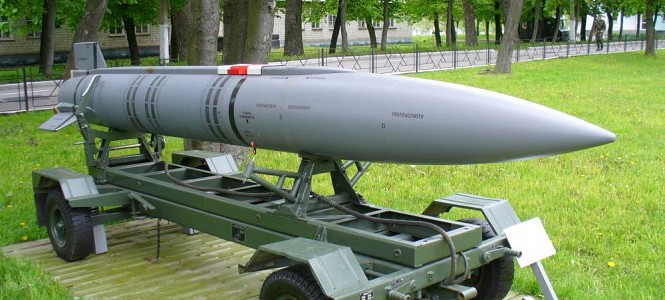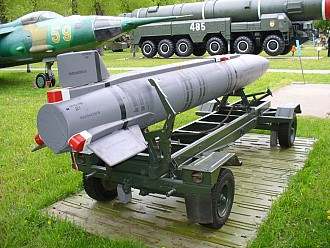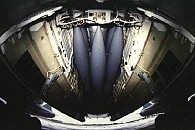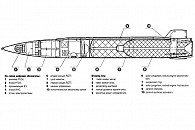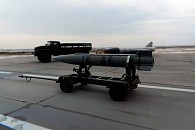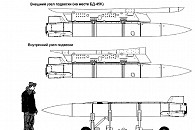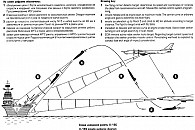Munitions / Air to surface missiles / Kh-15
Kh-15
General Facts
- TYPE
Air to ground missile - ORIGIN
 USSR
USSR - NICKNAMES
AS-16 Kickback (NATO reporting name)
RKV-15 (alternative designation) - DESIGNED
1978 - 1980's - DESIGNER
MKB Raduga - PRODUCTION
Mid 1980's - 1991? - PRODUCERS
 USSR - Dubna machinebuilding plant (DMZ)
USSR - Dubna machinebuilding plant (DMZ) - QUANTITY
Number of missiles produced is unknown. Original nuclear tipped Kh-15 outnumbers the anti-shipping and anti-radiation models. - UNIT COST
Unknown - CHARACTERISTICS
 Very high terminal speed
Very high terminal speed
 Difficult to intercept
Difficult to intercept
 Long range for supersonic missile of this size
Long range for supersonic missile of this size
 Uses expensive heat resistant components
Uses expensive heat resistant components
Introduction
The Kh-15 is a supersonic strategic air to ground missile of Soviet origin. It was developed in the late Cold War era as the Soviet counterpart to the American AGM-69 SRAM. In the West it is known under NATO reporting name AS-16 Kickback. The Kh-15 is a capable missile that is difficult to intercept.
Layout
The Kh-15 originated from a protracted design effort that can be tracked back to the late 1960's. The Kh-15 is a large, sleek cylindrical missile with three small fins near the nozzle. To withstand the high airspeed the body is made of titanium alloy. The guideance section and warhead are located in the pointed nose section. The rest of the missile is made up by the solid fuel rocket motor. The original nuclear tipped Kh-15 uses a parabolic high altitude flight path in order to plunge down at high speed on its target. It is unclear whether the anti-radiation and anti-shipping variants use the same parabolic flight path.
Guidance
The original nuclear tipped Kh-15 uses inertial navigation in order to plunge down on the target area. The anti-radiation variant uses passive radar homing. The anti-shipping variant uses active radar homing and employs inertial navigation at first when used against targets at longer distances.
Firepower
The Kh-15 is fitted with a 350 kT nuclear warhead. The warhead on the conventional variants reportly weighs 150 kg. With its parabolic flight path the Kh-15 reachs speeds of up to Mach 5, making it the fastest air to ground missile in service. The maximum range is 280 km, but is highly dependent on launch parameters such as altitude and airspeed. Although the flight path is predictable the timeframe and missile speed make it difficult to intercept. The conventional variants are believed to use a straighter flight path with corresponding shorter range of 150 km and lower terminal speed.
Platforms
The Kh-15 can be fitted to three types of Soviet bomber aircraft. It is mainly used on the supersonic Tu-22M3 (Backfire-C) strategic and maritime strike bomber. It is able to carry 6 missiles in the MKU-6-1 rotary launcher in its bomb bay. Additionally 4 missiles can be carried on underwing pylons. The Tu-95MS-6 (Bear-H) can carry 6 missiles. The Tu-160 (Blackjack) strategic bomber can carry two MKU-6-1 rotary launchers internally for up to 12 missiles.
Users
The Kh-15 was only used by the USSR. All remaining weapons have been inherited by Russia, which currently is the sole operator. A number of Kh-15 missiles could have been inherited by Ukraine alongside the large number of strategic bomber aircraft. It is believed that these have never been operational in the Ukraine.
Kh-15
Kh-15: Original production model introduced in 1988. Features inertial navigation and has a 350 kT nuclear warhead. First flight tests carried out in 1980.
Kh-15A: Anti-shipping missile with active radar homing seeker and conventional warhead. Uses inertial navigation in the early stage. Also known as Kh-15S. Development took place in mid 1980's and small number adopted before collapse of USSR.
Kh-15P: Anti-radiation missile with passive radar homing seeker and conventional warhead. Flight testing began in late 1980's. Development reportedly stopped in 1991.
| Type | Air to ground missile |
|---|---|
| Diameter | 0.455 m body, 0.8 m wingspan |
| Length | 4.78 m |
| Weight | 1.200 kg |
| Guidance | Inertial without any mid course correction |
|---|---|
| Warhead | 350 kT nuclear warhead |
| Propulsion | SRM-160 solid fuel rocket engine |
| Speed | Mach 5.0 in terminal phase |
| Range | 50 - 280 km max range depending on launch parameters |
|---|---|
| Altitude | Parabolic flight with altitude up to 40 km |
| Engagement envelope | - |
| Remarks | Launch envelope is 300 m to 22 km altitude and airspeeds of 150 to 300 m/s |
| Type | Anti-ship missile |
|---|---|
| Diameter | 0.45 m body, 0.92 m wingspan |
| Length | 4.78 m |
| Weight | 1.200 kg |
| Guidance | Active radar homing, inertial guidance towards target area |
|---|---|
| Warhead | 150 kg conventional warhead |
| Propulsion | SRM-160 solid fuel rocket engine |
| Speed | Mach 5.0 in terminal phase |
| Range | 50 - 150 km max range depending on launch parameters |
|---|---|
| Altitude | Parabolic flight with altitude up to 40 km |
| Engagement envelope | - |
| Remarks | Launch envelope is 300 m to 22 km altitude and airspeeds of 150 to 300 m/s |

